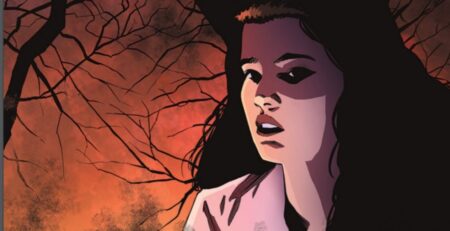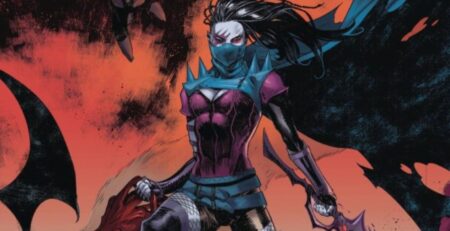
Nuclear Power #1 & 2 are written by Desirée Proctor and Erica Harrell and illustrated and lettered by Lynne Yoshii. The series is published by Fanbase Press. At the height of the Cuban Missile Crisis in 1962, a Russian submarine sets off a nuclear war that devastates the United States. In the present day, the remaining states have consolidated into the American Union and forged an iron wall to keep out radiation. When a pair of superpowered siblings break into the wall, Dr. Claudia Tocchi ends up being captured by them — and learning some dark truths about the Union in the process.
In the same way that Machine Gun Wizards injected the Prohibition era with mysticism and Ithaqa combined the events of that era with the mythos of H.P. Lovecraft, Nuclear Power takes a different approach to the nuclear fear of the ’60s and tensions between the U.S. and Russia. The American Union is the end result of unchecked, unquestioned patriotism: over the course of the two issues, a militarized hierarchy is revealed to be in power, mostly comprised of white men, and the rather chilling greeting of “May you rise from the ashes” is uttered every time they gather for important meetings.
The two issues center on Claudia, who is seeking a new way to test unborn babies for radiation-influenced disformities, and siblings Iris and Reed. Reed was granted the power to absorb and transfer heat, while Iris can split herself into multiple forms like an atom. I appreciate the thought that Proctor and Harrell put into developing Reed and Iris’s powers, but most importantly who the story is centered on.
Throughout both issues, readers will learn more about Claudia, including why she’s doggedly pursuing her research and her relationship with her husband Dean. She also has to deal with her superiors dismissing her theories due to her being, and I quote, “a naive young woman ruled by her emotions.” She’s also continually referred to as “Miss” despite being a doctor. Likewise, in Nuclear Power #2 it turns out that Reed and Iris’s powers spring from a dark secret surrounding the Union, and they’re dubbed as terrorists despite fighting for the truth. It’s not lost on me that the story is centered on a female scientist and two superpowered BIPOC; not only does it make the story more endearing but the microaggressions they encounter are all too real.
Yoshii’s art features very striking, yet simple designs, and a sepia tone that oddly enough reminded me of the films taken while nuclear testing was happening at the Bikini Atoll. Her best work happens to be with Reed and Iris, whose powers manifest in visually stunning ways. When Reed uses his powers, veins of energy spread through his fist, and his skin turns transparent. When Iris uses hers, she splits into a myriad of images, each one resembling the negative of a photo. In the same way that Proctor and Harrell put a great deal of thought into the siblings’ powers, Yoshii put a great deal of thought into how those powers would be represented visually.
Nuclear Power #1 & 2 presents an alternate version of history that mixes the superpowered allegory of X-Men with the political intrigue of The Man in the High Castle. If you’re a history buff or a superhero fan (or both) I suggest adding this book to your reading list.
The first two issues of Nuclear Power are currently available digitally on Comixology and Hoopla.
Nuclear Power #1 & #2
TL;DR
Nuclear Power #1 & 2 presents an alternate version of history that mixes the superpowered allegory of X-Men with the political intrigue of The Man in the High Castle. If you’re a history buff or a superhero fan (or both) I suggest adding this book to your reading list.







